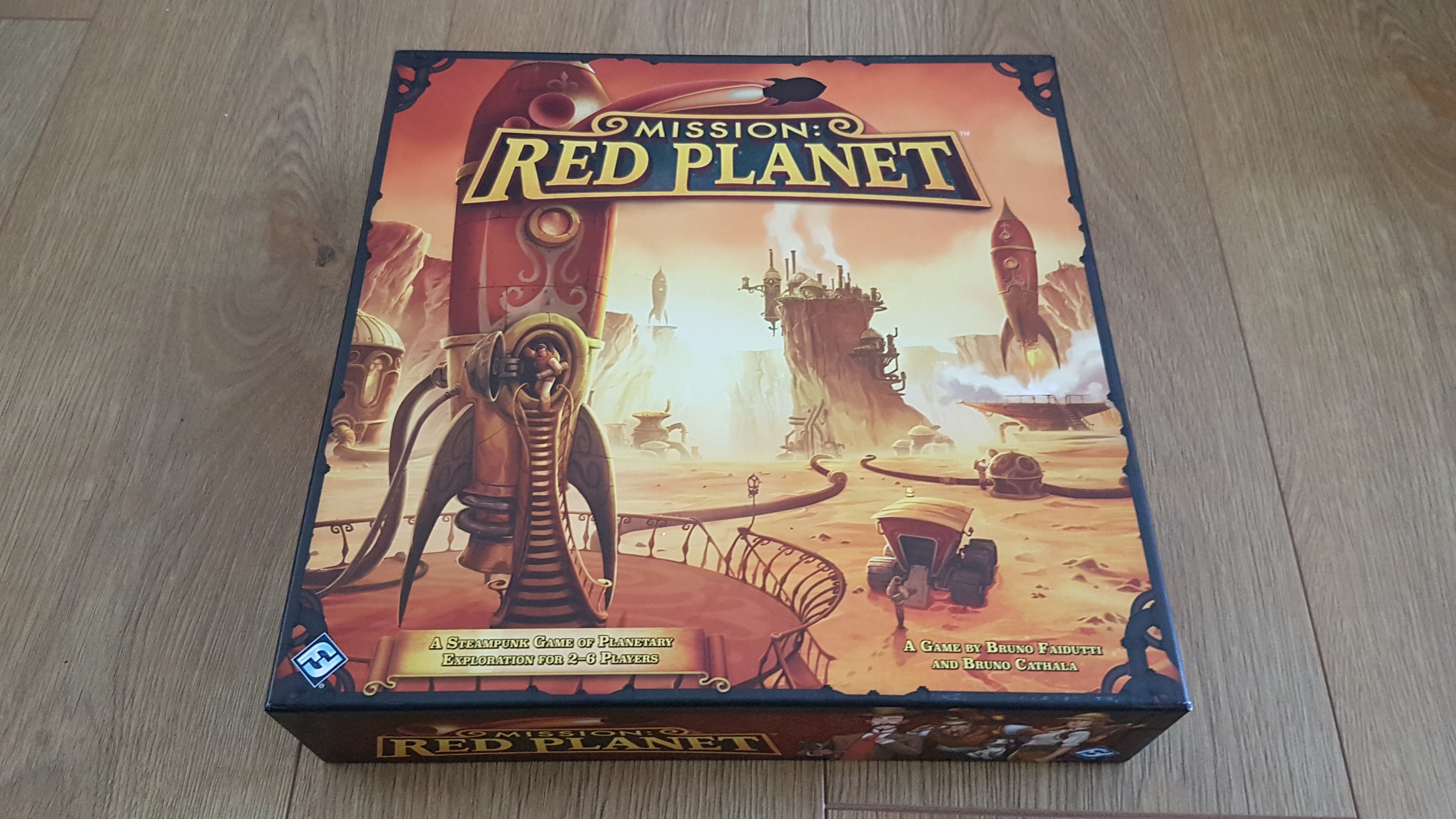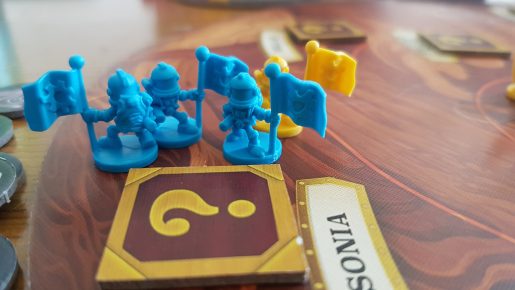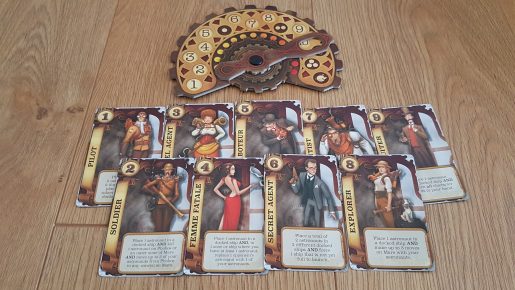Mission Red Planet (Second Edition) is a Steampunk Mars themed area control board game, released by Fantasy Flight Games back in 2015. As the lore goes the Victorians realised their resources were running low and when a new substance, Celerium, perfect for combustion-based power was found on Mars the mission was set. Designed by Bruno Cathala and Bruno Faidutti, the game sees 2 – 6 players, a slight increase from the original, exploring the surface of Mars and Mars’ moon Phobos. However, is the game as explosive as Celerium? Let’s find out!
The setup of Mission Red Planet is fairly simple, with a deck of cards and coloured astronauts handed to each player, a choice of 2 hidden objectives distributed to each player, resource tokens randomly assigned to each region of Mars (and Phobos) and the round counter is handed to the starting player. The game is played out over 10 rounds, with breaks for scoring after rounds 5, 8 and 10. Each round players will simultaneously select from their identical decks of cards one action to play. The general objective is to load your astronauts onto docked ships, bound for the red planet, then move them onto regions to have control via majority.
Docked ships have destinations, which are regions on the planet or the moon of Phobos. Some of the action cards will enable a player to add astronauts onto docked ships, while others see them take-off before being full or even being destroyed – seeing the occupants lost to space. Despite there being a first player each round, turn order isn’t simply around the table. Each action has a number, starting a countdown from 9 players reveal which action they chose to take. The reason for there being a first player is that the table turn order break ties. This is key for when the docked ships are filling up as it can mean someone in last place is unable to place any astronauts into the ships. Once a docked ship is full it leaves the dock area and at the conclusion of the round sees the units aboard dumped onto the map at the indicated destination. This sees players starting to get units on the ground to control areas of Mars.
There are a few special actions though, for example playing action number 9 “Recruiter”, sees the player both place a single astronaut and pick up all their used action cards. Potentially a game changing card to play is the Scientist, number 7, which sees the player able place 2 astronauts in either 1 or 2 docked ships and most importantly draw an event card. These come in three forms: missions, discovers and actions.
The mission cards are just like the cards distributed during setup and offer the player an additional secret way to rake up some points. For example, Settlement gains you one point for each astronaut in a zone of your choice on Mars! Discoveries alter the way that a single region scores points in the final round and are only revealed before that point scoring round. When a player gains one of these cards they get to choose an area to effect, which can be either positively or negatively. Actions cards are kept secret and players can choose to activate them when the card allows them, this can be either before or after the discoveries are revealed, before the final scoring round.
After round 5, 8 and 10 is the scoring phase. Depending on if it is the 1st, 2nd or 3rd scoring phase the player controlling an area will receive 1, 2 or 3 tokens respectively. There are three types of resources, that were randomly assigned to regions during setup, these are: Ice, Sylvanite and Celerium. These resources, which are worth 1, 2 and 3 points respectively, can build up quickly, for example in the second scoring phase controlling a Celerium area would score 2 x 3-point tokens. Before final points are calculated players determine whom has the most ice tokens, which bags them the communal objective worth 9 points, and which player objectives were completed. At the end of the game the winner is whomever has the most points.
As far as the theme goes it is slightly loose on the steampunk front. The cards feature steampunk themed characters but aside from this the theme is closer to a simple space exploration narrative. Removing the hints towards the Victorian-era and you’d have a game than makes just as much sense, making it feel strapped on just to make the game stand out. Conversely, the space section of the theme is very strong; especially when it comes to the countdown for the order to play cards, almost being determined by a blast off countdown the docked ships would use.
The production of this second edition of Mission Red Planet is top quality. The circle shaped game board pieces together cleanly and presents something visually different for players to fight over. The astronauts that act as player pieces are awesome tiny space suited people which are excellent at getting players involved with the space side of the theme. Even the ship cards, which could have been card to be that step above, perfectly extend the illustration of the docked area.
The major issue is one that feels like randomness, due to the way the entire game can be altered out of your control. As the discoveries and actions take place after the final action round, but prior to scoring, best made plans can suffer at the fate of the card draws of others. On top of this, the way the Saboteur is able to blow up a docked ship add too much disruption into the title for it to be a fully strategic experience. In a title where some strategy is needed, the spikes of luck drains from the game.
The other crying shame of Mission Red Planet is just as the experience gets going, players have boots on the ground and the area control element starts to shine, the end swiftly arrives. With a large amount of pieces on the board, suddenly the choices of what docked ships to board and movement on Mars have visible consequences. While this point does gradually become earlier it still only leaves the final few rounds for players choices to seem significant. This is somewhat driven by the fact there are a total of 9 cards and only 10 rounds. This gives little chance use combinations despite players having a lot of choice of what to play. It is both a luxury to have so much choice but a pitfall where there isn’t enough time to play out even a small slice of the potential choices.
I hoped Mission Red Planet would be a fast-paced area control game, with a depth of player choice and an interesting theme. Perhaps that just isn’t possible. The Martian portion of the theme shines through, but the sprinkling of Steampunk is so limited it makes itself redundant. The limitations added in by the fast rounds means despite the vast number of choices players come out the other side of the experience feeling they have had little impact. When games can swing on the cards drawn it almost negates the choices made. The title will hit the table a few more times, with the boarding mechanics giving the experience that unique element. However, Mission Red Planet doesn’t shout out as a game that’ll continually inspire enough enjoyment to permanently stay on the shelf.
[Editor’s Note: Mission Red Planet was provided to us by Asmodee UK for review purposes. The game is currently available on 365 Games for £32.99. It is also available from local UK board game stores, find your local store here]




